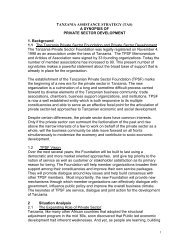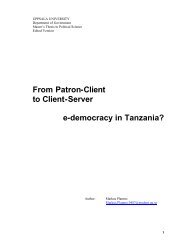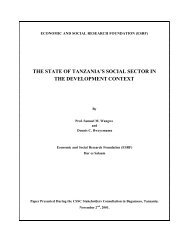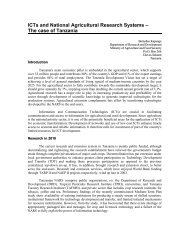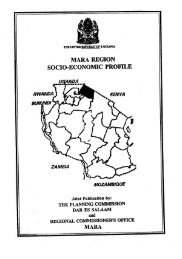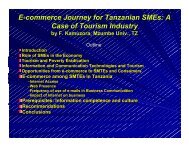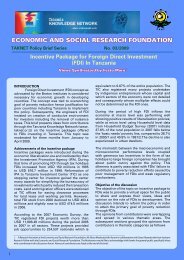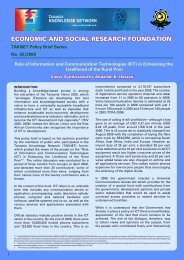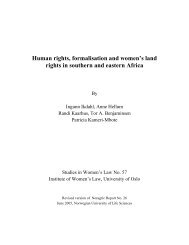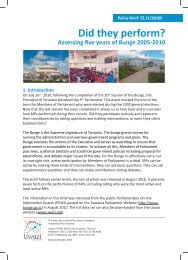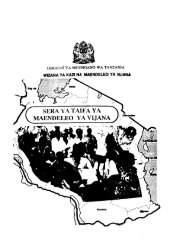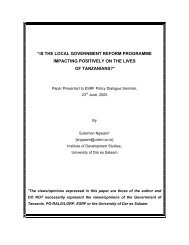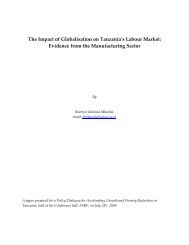- Page 2 and 3: TABLE OF CONTENTS Pages FOREWORD...
- Page 4 and 5: 4.3.8 Future Strategy:.............
- Page 6 and 7: FOREWORD 1. As we approach the 21st
- Page 8 and 9: December, 1998 vii
- Page 10 and 11: Kilimanjaro region is divided into
- Page 12 and 13: Wachagga was defeated and the Germa
- Page 14 and 15: Fig. 2: Population Distribution by
- Page 16 and 17: Fig. 3a: Population Census Results
- Page 18 and 19: Total 23,170,993 19.8 26.2 32 Sourc
- Page 21 and 22: Fig. 3c: Thousands 160 140 120 100
- Page 23 and 24: TABLE V(c): POPULATION DISTRIBUTION
- Page 25 and 26: Source: Population Census 1988, Kil
- Page 27 and 28: Table VI: Lifetime Migration By Reg
- Page 29 and 30: Mwanga 1143 16185 347 15338 33013 S
- Page 31 and 32: The Kilimanjaro region comprised of
- Page 33: Table VIII: SUMMARY OF AGRO-ECONOMI
- Page 36 and 37: - Cultivation and housing is very d
- Page 38 and 39: 2.0 REGIONAL ECONOMY 2.1 Introducti
- Page 40 and 41: Table IX: REGIONAL GDP AT CURRENT P
- Page 42 and 43: Table X: Regional GDP and Contribut
- Page 45 and 46: 2.3 Socio-economic Indicators: Tabl
- Page 47: eans and dairy cattle. The Wheat zo
- Page 51 and 52: Beans 31409 23667 11562 17503 22326
- Page 53 and 54: is 90,929.0 Metric tons while the a
- Page 55 and 56: Table XV(a): 14 percent. Table show
- Page 57 and 58: TABLE XV(b): Region Kilimanja r o H
- Page 59 and 60: 2.4.1.10Irrigation: According to th
- Page 61 and 62: TABLE XVII: DAM IRRIGATION WATER SO
- Page 63 and 64: TABLE XVIII: LOWER MOSHI AND NDUNGU
- Page 65 and 66: TABLE XXI: PESTICIDES MADE AVAILABL
- Page 67 and 68: TABLE XXIII: In comparison with reg
- Page 69 and 70: Thousands 500 400 300 200 100 0 198
- Page 71 and 72: Source: Mpango wa Maendeleo wa Mwak
- Page 73 and 74: The region has 24 Artificial Insemi
- Page 75 and 76: 1993/94 46 226 23 52333 9137 1734 1
- Page 77 and 78: In addition to the above mentioned
- Page 79 and 80: There are 19 operating government n
- Page 82 and 83: 2.4.3.3 Fishing: Fishing industry i
- Page 84 and 85: 12000 10000 8000 6000 4000 2000 0 1
- Page 86 and 87: TABLE XXXV: BEE-KEEPING PRODUCTS AN
- Page 88 and 89: Fig. 11: Production of Bee-wax and
- Page 90 and 91: Milk Production - - - - 1 - Malt -
- Page 92 and 93: SECTION III 3.0 ECONOMIC INFRASTRUC
- Page 95 and 96: TABLE XL: District TOTAL ROAD MILAG
- Page 97 and 98: In general, Kilimanjaro region has
- Page 99 and 100:
TABLE XLI: HOUSEHOLDS WITH ELECTRIC
- Page 101 and 102:
embarking on extensive afforestatio
- Page 103 and 104:
schools has the best proportion of
- Page 106 and 107:
TABLE XLIV: EXPANSION OF PRIMARY SC
- Page 108 and 109:
TABLE XLVII: ENROLMENT (THOUSANDS)
- Page 110 and 111:
Fig. 13: Total Enrolment in Public
- Page 112 and 113:
Fig. 14: Pupils Selected For Form I
- Page 114 and 115:
2500 2000 1500 1000 500 0 1991 1992
- Page 116 and 117:
Fig. 16: Reason for Drop-Outs in 19
- Page 118 and 119:
TABLE: LIII: DROP-OUTS FROM PRIMARY
- Page 120 and 121:
Rombo Buildings Required Actual Sho
- Page 122 and 123:
Fig. 18b: Situation of Staff houses
- Page 124 and 125:
116 Furnitures Required Actual S h
- Page 126 and 127:
35000 30000 25000 20000 15000 10000
- Page 128 and 129:
TABLE LVII (a) District TEACHERS ST
- Page 130 and 131:
district in 1997 may be attributed
- Page 132 and 133:
TABLE LXI: ENROLMENT IN PUBLIC AND
- Page 134 and 135:
The region’s enrolment sex ratio
- Page 136 and 137:
TABLE LXII: ILLITERATE ADULT POPULA
- Page 138 and 139:
TABLE LXIV: LITERACY RATES BY SEX F
- Page 140 and 141:
132
- Page 142 and 143:
TABLELXVI: COMMON DISEASES IN % IN
- Page 144 and 145:
The regional hospital forms the ape
- Page 146 and 147:
Rombo 198,50 99.3 1,300 0.7 - - Mos
- Page 148 and 149:
Fig. 24: The Ratio of Population pe
- Page 150 and 151:
(c) Hospital Services: TABLE LXXI:
- Page 152 and 153:
may be attributed to the regions so
- Page 154 and 155:
MAINLAN D 44 50 49 51 Source: Healt
- Page 156 and 157:
(c) Maternal Mortality: Maternal Mo
- Page 158 and 159:
One to reduce MMR is to ensure that
- Page 160 and 161:
TABLE LXXVa: CUMMULATIVE AIDS CASES
- Page 162 and 163:
TABLE LXXVI: from these sources. So
- Page 164 and 165:
Moshi Urban Moshi Rural Rombo Mwang
- Page 166 and 167:
TABLE LXXX: not functioning. Tables
- Page 168 and 169:
The region has shortage of working
- Page 170 and 171:
TABLE LIII: TECHNOLOGICAL MIX ADOPT
- Page 172 and 173:
TABLE LXXXIII(a): Urban Centres STA
- Page 174 and 175:
SECTION V 5.0 OTHER DEVELOPMENT ISS
- Page 176 and 177:
Source: Kilimanjaro Regional Commun
- Page 178 and 179:
(b) Moshi urban District Project/Ac
- Page 180 and 181:
15,387 under 7 years children. The
- Page 182 and 183:
5.3 Programmes and Various Activiti
- Page 184 and 185:
13. UNDP Household Grain Storage De
- Page 186 and 187:
20. Water Aid Construction of water
- Page 188 and 189:
There are about 52,000 heactares of
- Page 190 and 191:
• The Rare Forest in Kilimanjaro;
- Page 192 and 193:
ANNEX A KILIMANJARO REGION IN A NUT
- Page 194 and 195:
Operating Centres - 8 Dips - 56 Aba
- Page 196 and 197:
Regional GDP Per Capita at Curretnt
- Page 198 and 199:
Hospitals 16 5 11 Health Centres 18
- Page 200 and 201:
Total 266 ANNEX B HAI DISTRICT 1.0
- Page 202 and 203:
- Classrooms - 806 - Shortage of cl
- Page 204 and 205:
ANNEX C MWANGA DISTRICT 1.0 GENERAL
- Page 206 and 207:
2.0 ECONOMIC ACTIVITIES: - Agricult
- Page 208 and 209:
Government - 7 Private - 13 3.2 Hea
- Page 210 and 211:
2.0 ECONOMIC ACTIVITIES - Majority
- Page 212 and 213:
Rural Health Centres - 3 Dispensari
- Page 214 and 215:
ANNEX E ROMBO DISTRICT 1.0 GENERAL:
- Page 216 and 217:
- Number of Schools - 122 - Number
- Page 218 and 219:
3.3 Water: - Population (Rural) cov
- Page 220 and 221:
Temperature - 15 0 C - 25 0 C 2.0 E
- Page 222 and 223:
Hospitals - 4 Rural Health Centres
- Page 224 and 225:
MOSHI URBAN DISTRICT 1.0 GENERAL: A
- Page 226 and 227:
2.0 ECONOMIC ACTIVITIES: - Wage emp
- Page 228 and 229:
Tarmac roads - 60 kms Earth roads -
- Page 230 and 231:
Population TOTAL POPULATION AND LIF
- Page 232 and 233:
Climate (a) Rainfall Main rain seas
- Page 234 and 235:
1.3 NATIONAL PARKS National Parks (
- Page 236 and 237:
(vi)MIKUMI NATIONAL PARK LOCATION:
- Page 238:
(xi) GOMBE NATIONAL PARK LOCATION:



